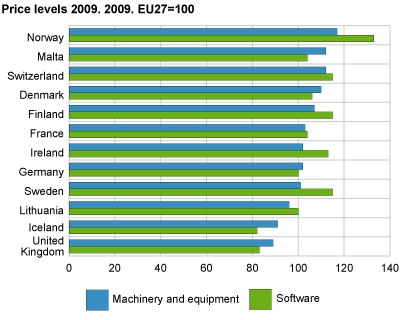Content
Published:
This is an archived release.
Norway most expensive
In 2009, Norwegian companies were facing Europe’s highest price level for investment goods. Both for machinery and equipment and for software, Norway was the most expensive country in Europe, according to newly released statistics from Eurostat.
The Norwegian price level for investment in machinery and equipment in 2009 was moderately 17 per cent above an average based on the 27 EU countries (EU27=100). Generally, there were small price level differences between the countries. A total of 32 out of 37 countries participating in the survey had price levels within +/- 10 per cent of the average. The price level in the most expensive country, Norway, was 31 per cent higher than in the country with the lowest price level, United Kingdom. The survey reflects the price levels that companies are facing when buying investment goods.
The impact of exchange rates
Iceland and United Kingdom stand out in the survey as the two cheapest countries. Compared to other similar surveys, this is rather surprising. In 2007, Iceland had a high price level for investment goods, close to the Norwegian level. In 2009, the Icelandic price level was clearly below the European average. United Kingdom has had a similar, though not so strong, decrease in relative price level. For both countries the reason behind this is a strong depreciation of the Icelandic króna and the British Pound Sterling respectively. Thus they appear as “cheaper” seen from abroad.
Electrical and optical equipment and metal products and equipment: small differences
In a Nordic context, the Norwegian price levels for electrical and optical equipment and metal products and equipment were only marginally higher than in Denmark, about 5 per cent higher than in Finland, and about 9 per cent higher than in Sweden. A possible reason for the homogenous price level for these product groups is perhaps that they are imported to a greater degree than consumer goods. The prices reflect "world market prices", and thus are less influenced by the countries' general level of costs.
Larger differences for transport equipment and software
The Norwegian price level for transport equipment was 26 per cent higher than in EU27, 14 per cent higher than in Denmark and Finland, and 31 per cent higher than in Sweden. The Norwegian price level for software also stands out; 33 per cent above EU27, 16 per cent higher than in Sweden and Finland, and 25 per cent higher than in Denmark.
Together with investment in construction, investment goods make up the National Account aggregate “Investments”. The price level survey results for “investment in construction” will be published in a separate article.
About the survey:Investment goods consist of the subgroups machinery and equipment and software. 1. Machinery and equipment: A. Metal products and equipment (fabricated metal products, engines and turbines, pumps and compressors, other general purpose machinery, agricultural and forestry machinery, machine tools, machinery for construction, machinery for food, beverages and tobacco processing, machinery for textile, apparel and leather production, other special purpose machinery). B. Electrical and optical equipment (office machinery, computers and other information processing equipment, electrical machinery and apparatus, radio, TV and communications equipment and apparatus, medical, precision and optical instruments, watches and clocks). C. Transport equipment 2. Software The price level indices per country are expressed in relation to the average of the 27 EU countries (EU27). For instance, if the index is 110, the price level for the country concerned is 10 per cent above the EU average. The survey was carried out within the framework of the European Comparison Programme 2009. The prices collected in the survey were exclusive of VAT, but include transport and delivery costs, and where relevant, assembly. |
More details in Eurostat ’s "Statistics in Focus".
Tables:
The statistics is now published as Comparison of price levels in Europe.
Contact
-
Statistics Norway's Information Centre
E-mail: informasjon@ssb.no
tel.: (+47) 21 09 46 42

